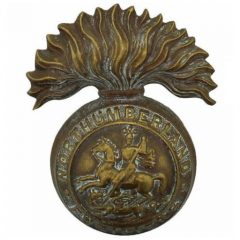Sanctuary Wood – June 1915 On Wednesday the 2nd the Royal Field Artillery (RFA) 1 forward observation post sited in the cottage in front of the Bn positions was shelled and set ablaze.…
You must be logged in to view the content of this Chapter.
Footnotes
- The Royal Field Artillery (RFA) was equipped with horse drawn medium calibre guns and howitzers, primarily to provide close support to the infantry in a war of movement. To be of use in trench warfare the guns had to be sited close to the front line
- Regimental Quarter Master Sergeant Andrew George Richardson (4/1) was the landlord of the Bush Inn (Hexham) prior to the war. During the winter of 1917/18 he was admitted to the Lord Derby War Hospital in Warrington suffering from shell shock and died on the 21st of June 1918. Richardson is buried in Hexham Cemetery
- The 7th, 8th and 9th Bdes were in the 3rd Divn. V Corps under Gen. Allenby was now comprised of the 3rd and 50th Divns with two Bdes of the 14th Light Divn attached
- L/Cpl Robert H. Temple (4/1891) had returned to England and was serving with the 3/4th NF on 1 Jan 1916
- The 2nd Royal Irish Rifles (7th Bde, 3rd Divn)
- Barbed wire
- Listeners used stethoscopes or placed tins of water in the trenches and checked for ripples. The geophone (a device which converts ground movement into an electrical signal) was soon employed
- Listening posts were often located at the head of a Sap. Occupants of these posts were expected to keep a close watch for any signs of enemy activity in the vicinity, such as mining operations, preparations for gas attack or even enemy wiring parties.
- A ‘Jumping off’ trench refers to one from which an infantry attack could be launched
- 19th of June edition of the Hexham Courant
- Pte Edward R. Wright (4/1234) ‘C’ Coy (b. Haltwhistle) (e. Haltwhistle). Was employed at Plenmellor Colliery prior to the war. He was with the Bn when it embarked for France on 20 Apr 1915
- The shortage of artillery shells during 1915 was a well reported national scandal
- The Mortar was essentially a tube into which explosive projectiles were dropped and fired at an angle greater than 45̊ in order clear obstructions and fall onto the enemy. The mortar was a very effective weapon for trench warfare
- 3rd Divn was comprised on the 7th, 8th and 9th Bdes. The 1st NF was in the 9th Bde
- 'Y' and Railway Woods lay between the Ypres-Roulers railway line and the Ypres-Menin road
- Brigade Major – Major Moore
- Captain Dixon
- In 1890, the Surrey town of Bisley became the home of the UK National Rifle Association Championships, which moved there from Wimbledon
- The ‘Parados’ refers to the rear face of the trench. It was usually lined with sandbags and built higher than the parapet (front face) so that soldiers were not silhouetted or hit by soldiers firing from behind
- Viewed from the air front line trenches had a crenulated appearance, because they were formed by digging alternate Firebays and Traverses. This was to prevent the enemy from firing along the trench should they succeed in entering
- Good fettle – good shape, spirits
- 42nd Brigade was part of the New Army 14th (Light) Divn which arrived in France during May 15
- 7th Brigade - 3rd Worcester Regt and 7th Royal Irish Rifles
- The three fusiliers killed and the one who subsequently died of his wounds were Pte Harry Bell (4/1371), ‘D’ Coy (b. Mickley) (e. Prudhoe). John Robson (4/1652) ‘D’ Coy (b. Prudhoe) (e. Prudhoe). Clarence Greathead (4/1850) (b. West Hartlepool) (e. Hexham). (4/1975) ‘C’ Coy, aged 17 (b. Bardon Mill) (e. Hexham). All are commemorated on the Menin Gate Memorial in Ypres
- The 48th was a Territorial Divn comprised of the 143rd, 144th and 145th Bdes
- The obsolete QF 4.7 inch artillery gun was transferred to the Territorial Force when the Regular Army was re-equipped with the BL 60 pdr Mk1 gun. The 4.7 shell weighed 46lb and had a maximum range of 10,000 yards, but the gun was unstable, heavy (3.8 tonnes), and difficult to operate
- Maj. Gen. Sir William F. L. Lindsay
- Aldershot huts had been constructed earlier in the year with the windows facing the German lines boarded up. Bedding consisted of straw laid on the floor and light was supplied by a single oil lamp suspended from the ceiling. [zotpressInText item="{XPGKKP8I}"]
- General Sir Charles Fergusson – GOC 2nd Army Corps. He was GOC 5th Divn in August 1914, briefly commanded 9th (Scottish) Divn from Oct to Dec 1914. Commanded II Corps from Jan 1915 and then, from May 1916, XVII Corps until the end of the War
